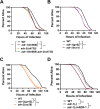ADARs regulate cuticle collagen expression and promote survival to pathogen infection
- PMID: 38360623
- PMCID: PMC10870475
- DOI: 10.1186/s12915-024-01840-1
ADARs regulate cuticle collagen expression and promote survival to pathogen infection
Abstract
Background: In all organisms, the innate immune system defends against pathogens through basal expression of molecules that provide critical barriers to invasion and inducible expression of effectors that combat infection. The adenosine deaminase that act on RNA (ADAR) family of RNA-binding proteins has been reported to influence innate immunity in metazoans. However, studies on the susceptibility of ADAR mutant animals to infection are largely lacking.
Results: Here, by analyzing adr-1 and adr-2 null mutants in well-established slow-killing assays, we find that both Caenorhabditis elegans ADARs are important for organismal survival to gram-negative and gram-positive bacteria, all of which are pathogenic to humans. Furthermore, our high-throughput sequencing and genetic analysis reveal that ADR-1 and ADR-2 function in the same pathway to regulate collagen expression. Consistent with this finding, our scanning electron microscopy studies indicate adr-1;adr-2 mutant animals also have altered cuticle morphology prior to pathogen exposure.
Conclusions: Our data uncover a critical role of the C. elegans ADAR family of RNA-binding proteins in promoting cuticular collagen expression, which represents a new post-transcriptional regulatory node that influences the extracellular matrix. In addition, we provide the first evidence that ADAR mutant animals have altered susceptibility to infection with several opportunistic human pathogens, suggesting a broader role of ADARs in altering physical barriers to infection to influence innate immunity.
Keywords: C. elegans; Double-stranded RNA (dsRNA); Innate immunity; P. aeruginosa; Post-transcriptional regulation; RNA editing; RNA modification; RNA-binding protein.
© 2024. The Author(s).
Conflict of interest statement
The authors declare that they have no competing interests.
Figures





Similar articles
-
ADBP-1 regulates ADR-2 nuclear localization to control editing substrate selection.Nucleic Acids Res. 2024 Sep 9;52(16):9501-9518. doi: 10.1093/nar/gkae641. Nucleic Acids Res. 2024. PMID: 39036970 Free PMC article.
-
The dsRBP and inactive editor ADR-1 utilizes dsRNA binding to regulate A-to-I RNA editing across the C. elegans transcriptome.Cell Rep. 2014 Feb 27;6(4):599-607. doi: 10.1016/j.celrep.2014.01.011. Epub 2014 Feb 6. Cell Rep. 2014. PMID: 24508457 Free PMC article.
-
A protein-protein interaction underlies the molecular basis for substrate recognition by an adenosine-to-inosine RNA-editing enzyme.Nucleic Acids Res. 2018 Oct 12;46(18):9647-9659. doi: 10.1093/nar/gky800. Nucleic Acids Res. 2018. PMID: 30202880 Free PMC article.
-
To protect and modify double-stranded RNA - the critical roles of ADARs in development, immunity and oncogenesis.Crit Rev Biochem Mol Biol. 2021 Feb;56(1):54-87. doi: 10.1080/10409238.2020.1856768. Epub 2020 Dec 27. Crit Rev Biochem Mol Biol. 2021. PMID: 33356612 Free PMC article. Review.
-
Mechanisms and implications of ADAR-mediated RNA editing in cancer.Cancer Lett. 2017 Dec 28;411:27-34. doi: 10.1016/j.canlet.2017.09.036. Epub 2017 Sep 30. Cancer Lett. 2017. PMID: 28974449 Review.
Cited by
-
ADR-2 regulates fertility and oocyte fate in C. elegans.bioRxiv [Preprint]. 2024 May 24:2023.11.01.565157. doi: 10.1101/2023.11.01.565157. bioRxiv. 2024. Update in: Genetics. 2024 Oct 7;228(2):iyae114. doi: 10.1093/genetics/iyae114. PMID: 37961348 Free PMC article. Updated. Preprint.
-
ADBP-1 regulates ADR-2 nuclear localization to control editing substrate selection.Nucleic Acids Res. 2024 Sep 9;52(16):9501-9518. doi: 10.1093/nar/gkae641. Nucleic Acids Res. 2024. PMID: 39036970 Free PMC article.
-
Past, Present, and Future of RNA Modifications in Infectious Disease Research.ACS Infect Dis. 2024 Dec 13;10(12):4017-4029. doi: 10.1021/acsinfecdis.4c00598. Epub 2024 Nov 21. ACS Infect Dis. 2024. PMID: 39569943
-
Conformational reorganization and phase separation drive hyper-editing of ADR-2-ADBP-1 complex.Nucleic Acids Res. 2025 Feb 27;53(5):gkaf148. doi: 10.1093/nar/gkaf148. Nucleic Acids Res. 2025. PMID: 40037706 Free PMC article.
-
ADR-2 regulates fertility and oocyte fate in Caenorhabditis elegans.Genetics. 2024 Oct 7;228(2):iyae114. doi: 10.1093/genetics/iyae114. Genetics. 2024. PMID: 39028799 Free PMC article.
References
MeSH terms
Substances
Grants and funding
LinkOut - more resources
Full Text Sources
Molecular Biology Databases
Research Materials

